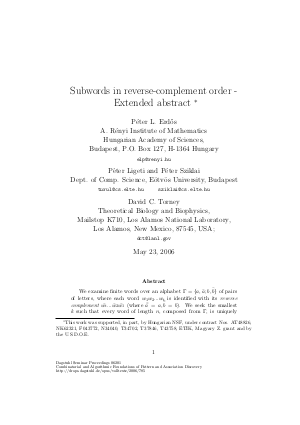Subwords in reverse-complement order
Authors Péter L. Erdös, Péter Ligeti, Péter Sziklai, David C. Torney
-
Part of:
Volume:
Dagstuhl Seminar Proceedings, Volume 6201
Part of: Series: Dagstuhl Seminar Proceedings (DagSemProc) - License:
 Creative Commons Attribution 4.0 International license
Creative Commons Attribution 4.0 International license
- Publication Date: 2006-11-07
File

PDF
DagSemProc.06201.10.pdf
- Filesize: 185 kB
- 8 pages
Document Identifiers
Subject Classification
Keywords
- Reverse complement order
- Reconstruction of words
- Microarray experiments
Metrics
- Access Statistics
-
Total Accesses (updated on a weekly basis)
0Document
0Metadata
Abstract
We examine finite words over an alphabet $Gamma={a,bar{a};b,bar{b}}$ of pairs of letters, where each word $w_1w_2...w_t$ is identical with its {it reverse complement} $bar{w_t}...bar{w_2}bar{w_1}$ (where $bar{bbar{a}}=a,bar{bar{b}}=b$). We seek the smallest $k$ such that every word of length $n,$ composed from $Gamma$, is uniquely determined by the set of its subwords of length up to $k$. Our almost sharp result ($ksim 2n/3$) is an analogue of a classical result for ``normal'' words.
This classical problem originally was posed by M.P. Sch"utzenberger and I. Simon, and gained a considerable interest for several researchers, foremost by Vladimir Levenshtein.
Our problem has its roots in bioinformatics.
Cite As Get BibTex
Péter L. Erdös, Péter Ligeti, Péter Sziklai, and David C. Torney. Subwords in reverse-complement order. In Combinatorial and Algorithmic Foundations of Pattern and Association Discovery. Dagstuhl Seminar Proceedings, Volume 6201, pp. 1-8, Schloss Dagstuhl – Leibniz-Zentrum für Informatik (2006)
https://doi.org/10.4230/DagSemProc.06201.10
BibTex
@InProceedings{erdos_et_al:DagSemProc.06201.10,
author = {Erd\"{o}s, P\'{e}ter L. and Ligeti, P\'{e}ter and Sziklai, P\'{e}ter and Torney, David C.},
title = {{Subwords in reverse-complement order}},
booktitle = {Combinatorial and Algorithmic Foundations of Pattern and Association Discovery},
pages = {1--8},
series = {Dagstuhl Seminar Proceedings (DagSemProc)},
ISSN = {1862-4405},
year = {2006},
volume = {6201},
editor = {Rudolf Ahlswede and Alberto Apostolico and Vladimir I. Levenshtein},
publisher = {Schloss Dagstuhl -- Leibniz-Zentrum f{\"u}r Informatik},
address = {Dagstuhl, Germany},
URL = {https://drops.dagstuhl.de/entities/document/10.4230/DagSemProc.06201.10},
URN = {urn:nbn:de:0030-drops-7856},
doi = {10.4230/DagSemProc.06201.10},
annote = {Keywords: Reverse complement order, Reconstruction of words, Microarray experiments}
}
